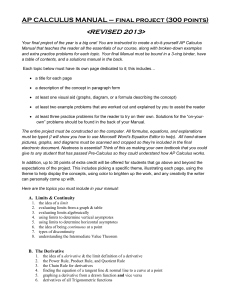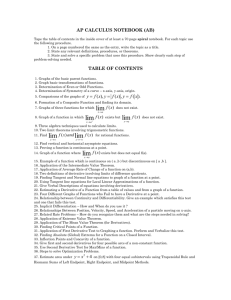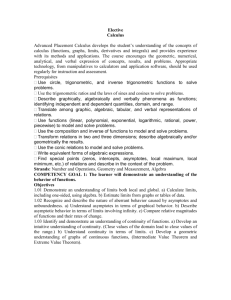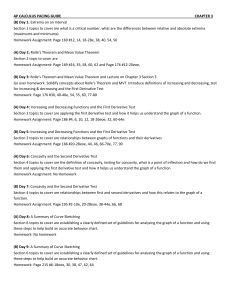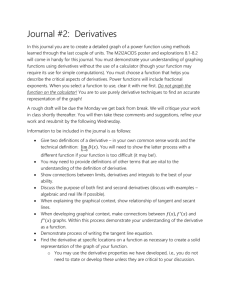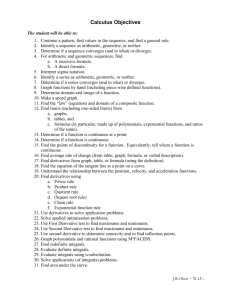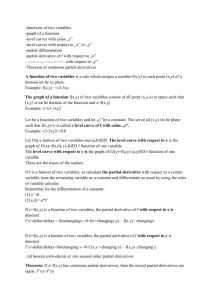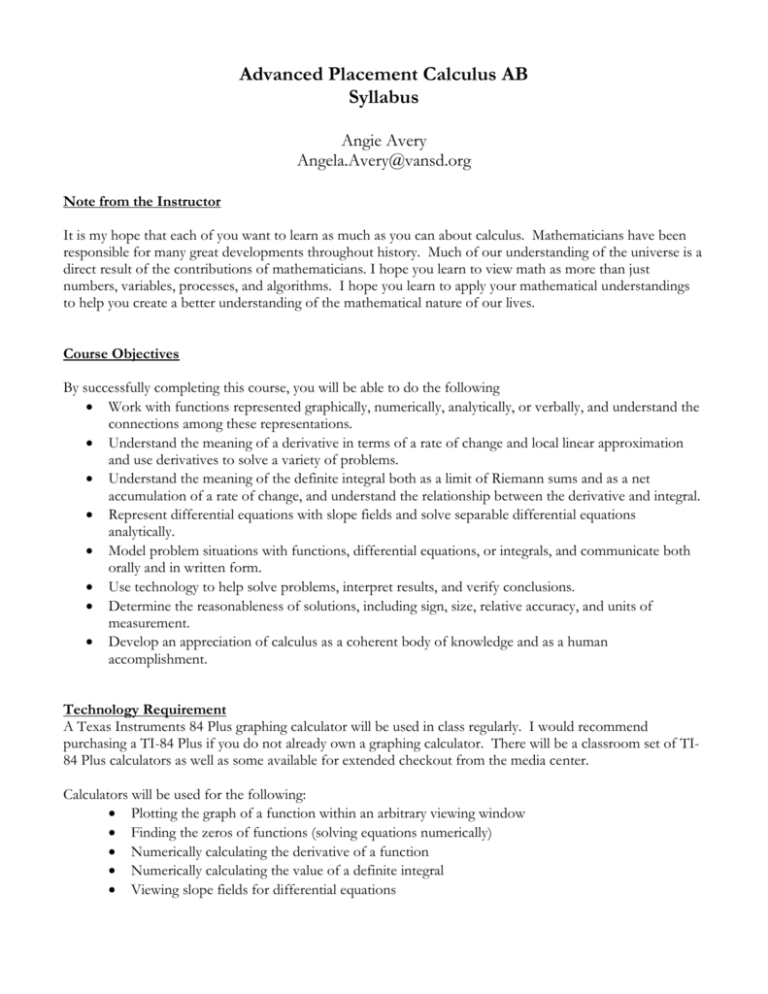
Advanced Placement Calculus AB
Syllabus
Angie Avery
Angela.Avery@vansd.org
Note from the Instructor
It is my hope that each of you want to learn as much as you can about calculus. Mathematicians have been
responsible for many great developments throughout history. Much of our understanding of the universe is a
direct result of the contributions of mathematicians. I hope you learn to view math as more than just
numbers, variables, processes, and algorithms. I hope you learn to apply your mathematical understandings
to help you create a better understanding of the mathematical nature of our lives.
Course Objectives
By successfully completing this course, you will be able to do the following
Work with functions represented graphically, numerically, analytically, or verbally, and understand the
connections among these representations.
Understand the meaning of a derivative in terms of a rate of change and local linear approximation
and use derivatives to solve a variety of problems.
Understand the meaning of the definite integral both as a limit of Riemann sums and as a net
accumulation of a rate of change, and understand the relationship between the derivative and integral.
Represent differential equations with slope fields and solve separable differential equations
analytically.
Model problem situations with functions, differential equations, or integrals, and communicate both
orally and in written form.
Use technology to help solve problems, interpret results, and verify conclusions.
Determine the reasonableness of solutions, including sign, size, relative accuracy, and units of
measurement.
Develop an appreciation of calculus as a coherent body of knowledge and as a human
accomplishment.
Technology Requirement
A Texas Instruments 84 Plus graphing calculator will be used in class regularly. I would recommend
purchasing a TI-84 Plus if you do not already own a graphing calculator. There will be a classroom set of TI84 Plus calculators as well as some available for extended checkout from the media center.
Calculators will be used for the following:
Plotting the graph of a function within an arbitrary viewing window
Finding the zeros of functions (solving equations numerically)
Numerically calculating the derivative of a function
Numerically calculating the value of a definite integral
Viewing slope fields for differential equations
Textbook
Finney, Demana, Waits and Kennedy. Calculus – Graphical, Numerical, Algebraic. Third edition. Pearson,
Prentice Hall, 2007.
This textbook will be our primary resource. Students will benefit from reading each section. The text
contains a number of interesting explorations and I encourage students to work through these together in
order to construct understanding.
A Balanced Approach
This course will emphasize a “Rule of Four” technique: analytic/algebraic, numerical, graphical, and verbal
methods of representing problems. Students must value each method, understand how they are connected to
a given problem, and learn how to choose the most appropriate for a given problem.
With this balanced approach, students will be expected to do the following:
Obtain solutions algebraically or analytically
Support answers graphically or numerically with technology
Interpret the result in the original problem context
Course Outline – Tentative Timeline
Unit 1: Limits and Continuity (3-4 weeks)
A. Rates of Change
a. Average Speed
b. Instantaneous Speed
B. Limits at a Point
a. One-sided Limits
b. Two-sided Limits
c. Sandwich Theorem
i. In order to help tie the graphical implications of the Sandwich Theorem to the
analytical applications of it, students will conduct an explorations where they graph the
following equations: y1=x^2, y2=-x^2, and y3=sin(1/x). They then attempt to “see”
the limit as x approaches 0 of x^2*sin(1/x).
C. Limits involving Infinity
a. Asymptotic behavior
i. Horizontal
ii. Vertical
b. End behavior models
c. Properties of Limits – algebraic analysis
d. Visualizing Limits – graphical analysis
D. Continuity
a. Continuity at a point
b. Continuous functions
c. Discontinuous functions
i. Removable discontinuity
1. Table groups conduct a tabular investigation of the limit as x approaches 1 of
f(x) = (x^2 – 7x – 6)/(x – 1). Then the same group conducts an analytic
investigation of the same function. Students in the group will then draw
conclusions based on their observations. Finally, students will use their
graphing calculators to graph the function and discuss, as a class, whether or
not their table’s conclusions were verified or contradicted.
ii. Jump discontinuity
iii. Infinite discontinuity
E. Rates of Change and Tangent Lines
a. Average rate of change
b. Tangent line to a curve
c. Slope of a curve – algebraically and graphically
d. Normal line to a curve – algebraically and graphically
e. Instantaneous rate of change
Unit 2: The Derivative (5-6 weeks)
A. Derivative of a Function
a. Definition of the derivative
i. Difference Quotient
b. Derivative at a Point
c. Relationships between the graphs of f and f’
d. Graphing a derivative from data
e. One-sided derivatives
B. Differentiability
a. Cases where f’(x) fail to exist
b. Local Linearity
c. Derivatives on the calculator
d. Symmetric difference quotient
e. Relationship between differentiability and continuity
f. Intermediate Value Theorem for Derivatives
C. Rules for Differentiation
a. First order derivatives
i. Constant, power, sum, difference, product, and quotient Rules
b. Higher order derivatives
D. Applications of the Derivative
a. Position, velocity, acceleration, and jerk
b. Particle motion
c. Economics
i. Marginal Cost
ii. Marginal Revenue
iii. Marginal Profit
E. Derivatives of Trigonometric Functions
F. Chain Rule
G. Implicit Differentiation
a. Differential method
b. y’ method
H. Derivatives of Exponential and Logarithmic Functions
Unit 3: Applications of the Derivative (5-6 weeks)
A. Extreme Values
a. Relative Extrema
b. Absolute Extrema
c. Critical Points
B. Implications of the Derivative
a. Rolle’s Theorem
b. Mean Value Theorem
c. Increasing and Decreasing functions
C. Connecting f’ and f’’ with the graph of f(x)
a. First Derivative Test
b. Second Derivative Test
i. Concavity
ii. Inflection Points
iii. Relative Maximum/Minimum
1. Students play a matching game with laminated cards which represent functions
in 4 ways: a graph of the function, a graph of the derivative, a written
description of the function, and a written description of the derivative.
D. Optimization Problems
E. Linearization Models
a. Local Linearization
b. Tangent Line Approximations
c. Differentials
F. Related Rates
Unit 4: The Definite Integral (3-4 weeks)
A. Approximating Area
a. Riemann Sums
i. LRAM
ii. RRAM
iii. MRAM
iv. Trapezoidal sums
1. Students are given a program to input into their graphing calculators which
calculates the trapezoidal sums for trapezoids of equal width. Students are
encouraged to think about altering the program to calculate rectangular sums.
b. Definite Integrals
1. Each student is asked to draw a linear function of their choosing. Then they
are asked to use known geometric methods to calculate the definite integral
over a given interval. Students then share their work with their tablemates.
c. Properties of Definite Integrals
i. Power Rule
ii. Mean Value Theorem for Definite Integrals
d. The Fundamental Theorem of Calculus
Unit 5: Diffential Equations and Mathematical Modeling (4 weeks)
A. Slope Fields
B. Antiderivatives
a. Indefinite Integrals
b. Power Formula
c. Trigonometric Formulas
d. Exponential and Logarithmic Formulas
C. Separable Differential Equations
a. Growth and Decay
b. Slope Fields
c. General Differential Equations
d. Newton’s Law of Cooling
D. Logistic Growth
Unit 6: Applications of Definite Integrals (3 weeks)
A. Integral as net change
a. Calculating distance traveled
b. Consumption over time
c. Net change from data
B. Area Between Curves
a. Area between a curve and an axis
i. Integrating with respect to x
ii. Integrating with respect to y
b. Area between intersecting curves
i. Integrating with respect to x
ii. Integrating with respect to y
C. Calculating Volume
a. Cross Sections
b. Disc Method
c. Shell Method
Unit 7: Review/Test Preparation (4 weeks)
A. Test taking strategies
a. Multiple Choice
b. Free Response
B. Practice
a. Multiple Choice
b. Free Response
i. Individual and Group practice
ii. Review rubrics for complete answers
iii. Collaborate to formulate responses
iv. Individual written responses
Unit 8: After the AP Exam (4-5 weeks) – scores will be treated as quizzes
A.
B.
C.
D.
Projects designed to incorporate course curriculum
Research projects on the historical development of mathematics
Advanced Integration
College placement exams/ College Math Requirements
Grading
Grades will include, but not limited to, the following: tests, quizzes, in-class activities, homework assignments,
projects and classroom participation.
Homework (10%) – assigned almost daily and is due at the beginning of the period the next time our
class meets. Assignments are graded based on your effort – If you legitimately attempt every
problem, show your work, and follow all directions you’ll receive full credit. Late work is only
accepted with a pass (2 per semester).
Quizzes (25%) – As long as we are covering new material, there will frequent quizzes, typically on Monday.
Quiz questions may be selected directly from problems covered in class (warm-ups, notes,
homework). The questions can come from any chapter, not just the chapter we are currently studying.
Quizzes may be timed. If you are absent for a quiz, you will take a similar quiz the day you return to
class. If the questions are not directly from questions covered in class, you will have the opportunity
to reflect for up to ½ credit back (see reflection process below). If questions come directly from
questions covered in class there will be no retakes or reflections. The final project after the AP exam
will also count as a quiz. It will have a large impact on your grade as we will have fewer quizzes during
the 2nd semester.
Tests (65%) – Tests will be divided into AP concepts covered in a particular chapter. This means that
when you receive your results to a test, you will be able to identify how you performed on each
concept separately. If you do not score well on a particular section, you may retake that section. Prior
to retake, you will be required to complete a reflection on the entire section. The reflection needs to
be stapled to the front of your test and will serve as your ticket into retake. No reflection, no retake. I
will set a time frame for retakes (usually around 2 weeks). I will expect all students that receive less
than a 70% to retake.
Reflection Process – Complete on a separate piece of paper and staple to the front of your original
quiz. Use complete sentences and be specific (you will not receive full credit unless you do).
1. Identify the concept missed for each incorrect problem.
2. Explain what you misunderstood about the concept or what was incorrect with your original
work.
3. Redo the problem completely, showing ALL work.
Grading Scale
A: 93-100 A-: 90-92 B+: 87-89 B: 83-86 B-: 80-82 C+: 77-79 C: 73-76 C-: 70-72 D+: 67-69 D:
60-66 F: below 60


